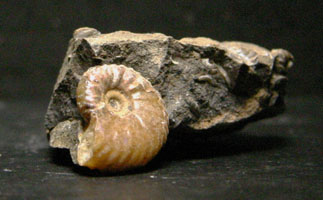Ammonites are an extinct order of carnivorous mollusks that were closely related to the squid, octopus, cuttlefish, and the chambered nautilus. Ammonites mysteriously became extinct at the same time as the dinosaurs some 65 million years ago. The term "ammonite" means "Ammon's Stone." The name was given to these coiled fossils by the Egyptians who noted their resemblance to the horns of their ram headed god, Ammon. Ammonites flourished in oceans for approximately 330 million years.
Ammonites are easily recognized by their beautiful geometrically coiled shells. These shells were secreted by the animal and continued to grow and provide protection for the creature throughout its life. The animal itself probably very closely resembled a modern day squid living in the end of the shell (similar to the chambered nautilus). An ammonite could control its buoyancy much like a submarine, filling its chambers in the shell with either gas or fluid. Ammonites became so prolific that they filled nearly every niche in the ocean.
Many of the ammonites from South Dakota will fluoresce due to the replacement of the shell by calcite and chalcedony. The calcite will fluoresce from white to yellow to orange. The chalcedony usually shows up as a green fluorescence. Usually the stronger fluorescence is under long wave and is the first photo shown in the fluorescents (South Dakota) section of the web site. Chalcedony usually does not fluoresce well under long wave, but does fairly well for the fossils from this area.
The specimen has been almost completely replaced by calcite. There is still some iridescence from the original shell at the top section of the specimen. Also check out other South Dakota fluorescent offerings under the Fluorescents section. Then click on the "To view specimen material from South Dakota" link. Some other normal light photos will be shown there as well.
The specimen is a Hoploscaphites (hoplo=heavily armed foot soldier + skaphe=boat + ites=a stone). They have a compressed or flattened side. The phragmocone is tightly coiled, with shallow umbilical walls and a short slightly curved body chamber. Ribs tend to be thicker on the phragmocone, becoming denser and finer on the body chamber. The ribs often bifurcate (divide) and bend back towards the phragmocone at mid-flank. Small ventrolateral tubercles (bumps) may be present on the body chamber and may or may not be present along the umbilical margin. They lived during the Campanian and Maastrichtian Stages of the Upper Cretaceous (100-70 MYA).
This specimen is also available in the fluorescent section under South Dakota fluorescent minerals and fossils. It will have the same item number without the "N" at the end of the number.
Hoploscaphites 
Quantity in Basket: None
Code: SDA-108N
Price: $25.00
Shipping Weight: 0.13 pounds
Time: Upper Cretaceous, Campanian and Maastrichtian Stages, approximately 100-70 million years ago.
Location: Pierre Shale, South Dakota, USA
Dimensions: 2" x 1-1/4" x 1"